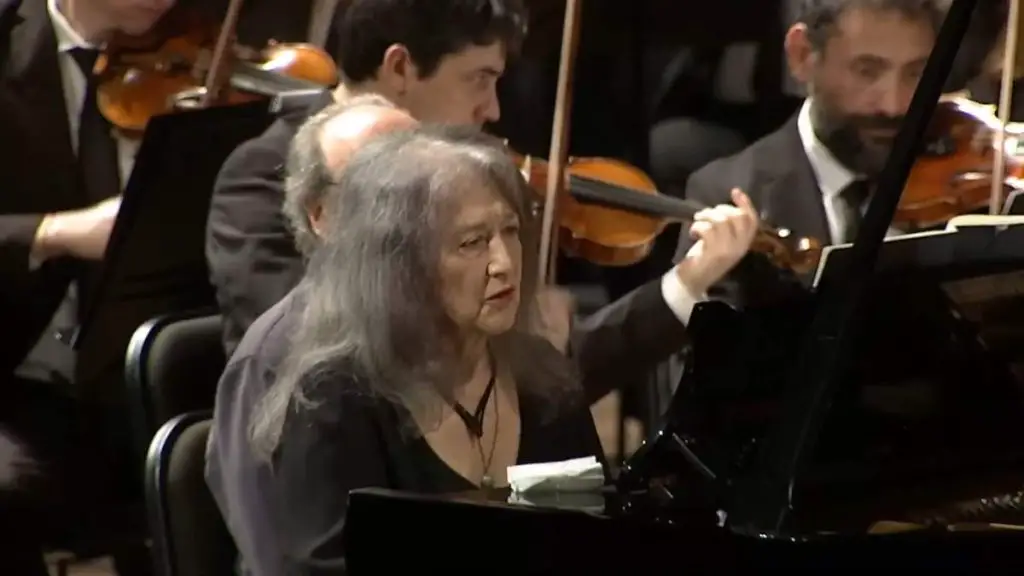Conducted by Seiji Ozawa, the Saito Kinen Orchestra and Chorus perform Ludwig van Beethoven’s Fantasy in C minor for Piano, Chorus, and Orchestra, Op. 80; simply known as the “Choral Fantasy”. Piano: Martha Argerich. This performance was in the summer of 2015.
- Olga Guryakova: soprano
- Marie-Nicole Lemieux: mezzosoprano
- Nikolai Schukoff: tenor
- Franz-Josef Selig: bass
Beethoven’s Choral Fantasy
The work was composed in 1808 and first performed at the Akademie (benefit concert) of 22 December 1808, which also saw the premieres of the Fifth and Sixth Symphonies and the Fourth Piano Concerto as well as a performance of excerpts of the Mass in C major.
The Choral Fantasy is divided into two movements:
- Adagio
- Finale. Allegro – Meno allegro (Allegretto) – Allegro molto – Adagio ma non troppo – Marcia, assai vivace – Allegro – Allegretto ma non troppo quasi andante con moto »Schmeichelnd hold und liebliech klingen« – Presto
The Fantasy opens with a slow but virtuosic 26-bar piano introduction, modulating from C minor to C major and back again. The main part of the piece, marked “Finale”, begins with an Allegro theme played by the cellos and basses. Next, the solo piano introduces the choral theme in an ornamented version. Variations on the theme are then played by the flutes, oboes, clarinets, and string soloists, respectively. A full orchestral version of the theme played at a forte dynamic leads into a more lyrical piano line.
The orchestra accompanies an eighth-note heavy piano part as the piece modulates from C minor to C major. A calm, flowing A-major section, ending with a call-and-response section between double reeds, horn, and piano, leads into the Marcia, an F-major variation on the main theme in march style. A reprise of the instrumental theme from the first Allegro transitions into the choral entrance.
The chorus enters with the sopranos and altos singing the main theme, harmonized in triads. The tenors and basses then sing the theme, after which the entire chorus is joined by the orchestra in a tutti rendition. A presto coda with orchestra, chorus, and piano brings the piece to a close.
Beethoven’s Choral Fantasy Text
German
Schmeichelnd hold und lieblich klingen
unseres Lebens Harmonien,
und dem Schönheitssinn entschwingen
Blumen sich, die ewig blühn.
Fried und Freude gleiten freundlich
wie der Wellen Wechselspiel.
Was sich drängte rauh und feindlich,
ordnet sich zu Hochgefühl.
Wenn der Töne Zauber walten
und des Wortes Weihe spricht,
muss sich Herrliches gestalten,
Nacht und Stürme werden Licht.
Äuss’re Ruhe, inn’re Wonne
herrschen für den Glücklichen.
Doch der Künste Frühlingssonne
lässt aus beiden Licht entstehn.
Großes, das ins Herz gedrungen,
blüht dann neu und schön empor.
Hat ein Geist sich aufgeschwungen,
hallt ihm stets ein Geisterchor.
Nehmt denn hin, ihr schönen Seelen,
froh die Gaben schöner Kunst
Wenn sich Lieb und Kraft vermählen,
lohnt den Menschen Göttergunst.
English translation
Graceful, charming and sweet is the sound
Of our life’s harmonies,
and from a sense of beauty arise
Flowers which eternally bloom.
Peace and joy advance in perfect concord,
like the changing play of the waves.
All that was harsh and hostile,
has turned into sublime delight.
When music’s enchantment reigns,
speaking of the sacred word,
Magnificence takes form,
The night and the tempest turns to light:
Outer peace and inner bliss
Reign o’er the fortunate ones.
All art in the spring’s sun
Lets light flow from both.
Greatness, once it has pierced the heart,
Then blooms anew in all its beauty.
Once one’s being has taken flight,
A choir of spirits resounds in response.
Accept then, you beautiful souls,
Joyously the gifts of high art.
When love and strength are united,
Divine grace is bestowed upon Man.
Saito Kinen Orchestra
The Saito Kinen Orchestra is an orchestra formed annually during the Saito Kinen Festival Matsumoto held every August and September in Matsumoto City, Nagano, Japan. The orchestra is managed by the Saito Kinen Foundation.
In September 1984, under the leadership of Seiji Ozawa and Kazuyoshi Akiyama, a group of Japanese musicians from all over the world gathered together in Japan to perform a series of concerts in commemoration of the 10th anniversary of the death of Hideo Saito—co-founder of the Toho Gakuen School of Music and mentor to those conductors and musicians. The series of memorial concerts performed in Tokyo and Osaka became the beginning of the career of the Saito Kinen Orchestra.

At the beginning of the orchestra’s establishment, its members would consist of Saito’s former students who agreed with Ozawa and Akiyama that they should assemble in Japan for the memorial concerts. They at first performed without being paid.
In 1987 the Orchestra made its first tour of Europe in Vienna, Berlin, Frankfurt, Paris, and London. Between 1989 and 1991, it toured in Europe and America. In 1990 the orchestra was invited to the Salzburg Festival.
In May 1992, the Saito Kinen Foundation was established. In September of the same year, the Saito Kinen Festival Matsumoto was held for the first time. As well as activities for the annual Festival such as performing symphonies, operas, and vocal compositions, and holding musician tutorials, the orchestra has also performed concerts in Tokyo.
Since the Saito Kinen Orchestra is an orchestra formed annually, there are no regular members. It originally consisted of Saito’s former students and the graduates from the Toho Gakuen School of Music. However, as the original members age, the orchestra has been adding new members, among them Ozawa’s former students and friends.
In 2008, the Orchestra was voted the world’s 19th greatest orchestra by a panel of critics assembled by Gramophone Magazine, a UK-based leading classical music magazine.
Sources
- Choral Fantasy (Beethoven) on Wikipedia
- Saito Kinen Orchestra on Wikipedia
- Choral Fantasy, Op. 80 (Ludwig van Beethoven) on the Choral Wiki website
- “Choral Fantasy in C Minor, Op. 80, work by Beethoven” on the Encyclopedia Britannica website


As of Oct. 1, 2021 URL https://www.youtube.com/watch?v=KGSP9ZPWURw is deleted; the performance is available at
URL https://www.youtube.com/watch?v=sewynauayk8